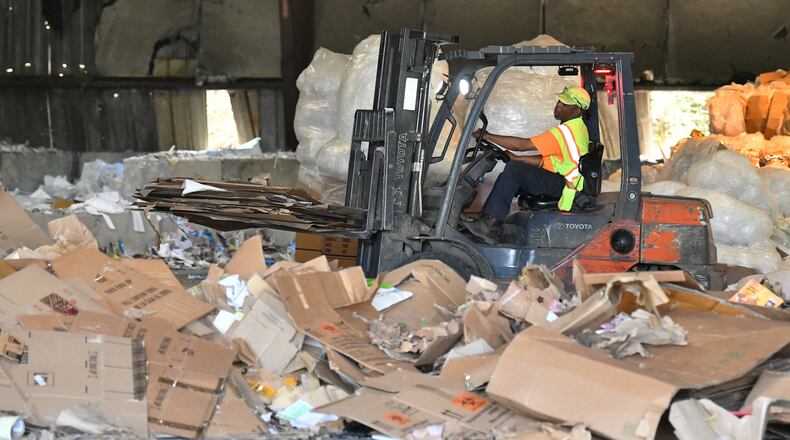One of the hotter commodities on the market today is not something from the mind of Elon Musk or from Apple’s laboratories.
It’s a 150-year-old technology that we still can’t get enough of, thanks to the coronavirus.
Corrugated cardboard boxes, both new and used.
When COVID-19 locked Americans at home in 2020, they began ordering in everything from fresh meal kits to office supplies and pizzas. At the same time, the factories that make the boxes slowed with new safety protocols and sick employees.
Prices for corrugated cardboard boxes are up about 10% from a year ago and inventories dropped to a three-week supply nationally in November, slowing some shipments.
Inventories are climbing again and Georgians should be able to keep having boxes delivered to their doorsteps. But it could cost them more: Some industry analysts predict prices will continue to rise with demand and the rising cost of buying used cardboard to recycle into new boxes.
Dustin Smith of BoldtSmith Packaging Consultants in Wisconsin said he repriced a box 20 inches long by 12 inches wide and six inches deep for a business customer this week, and it had risen from 37 cents to 45 cents over the past year.
If businesses pass those costs along to customers who order a lot of things on Amazon or do food takeout, it can add up quickly.
Atlanta-based Mellow Mushroom’s 178 restaurants scattered across 21 states use about 9 million pizza boxes a year. The company has not passed that cost along to the hungry yet, but “at some point, you may see prices go up,” said spokeswoman Anne Majia.
Credit: Pixabay
Credit: Pixabay
There is some good news for Georgians in the demand for boxes. The state is a major manufacturer of corrugated carboard, so workers and companies are working at high rates and overtime when some other industries are hurting.
Georgia’s $13.7 billion-dollar pulp and paper products industry is one of the nation’s largest. It employs nearly 20,000, according to the Georgia Forestry Association. Corrugated cardboard factories are scattered across Georgia from Columbus to Atlanta and back down to Savannah.
They helped the U.S. churn out a record 407 billion square feet of cardboard in 2020, says the Fibre Box Association. That’s 14,599 square miles of brown containerboard, as the industry calls it, about enough to cover Georgia from Atlanta’s Hartsfield-Jackson International Airport to the Tennessee state line.
Still, that has been barely enough to meet U.S. demand.
Usage had been growing slowly, in the 1% range yearly thanks to e-commerce, industry analysts say. When the pandemic hit, large sectors of the retail economy froze and cardboard demand dropped. But then online shopping boomed. During the last quarter of 2020, e-commerce was up about $50 billion from the same period during 2019.
Kevin Mason, managing director of ERA Forest Products Research, said demand for boxes climbed 3% by summer, and more than double that later, with “phenomenal gains in the back half of the year.”
Manufacturers of other products derived from Georgia’s 26.4 million acres of forests also have struggled to match supply with demand during the pandemic. Toilet paper, paper towels and lumber to build homes have been hard to secure at various times as demand surged.
Credit: TNS
Credit: TNS
Atlanta-based Georgia-Pacific executive Brian Smith told Marketplace late last year it has been a challenge for box makers to catch up, sometimes involving “running extra hours and into weekends.” A spokesman said the privately owned company, the No. 3 U.S. paper producer, saw box orders for e-commerce rise more than 30%.
Atlanta-based paper-goods company Westrock — the No. 2 U.S. paper producer behind International Paper in Memphis — reported in late January that by the end of 2020 it was putting out record corrugated box shipments, showing an 8% year-over-year increase on a per-day basis.
Corrugated cardboard prices rose from $715 a ton in January 2020 to $785 per ton in March, according to Bank of America Global Research packaging analyst George Staphos, who expects demand to remain high.
“Consumers, once we get used to a convenience, we don’t turn away from it,” he said.
Some companies such as Westrock are retooling and upgrading old paper machines to make corrugated cardboard materials to catch up to the demand. Some analysts expect the industry to catch up later this year as new production facilities come online.
In the meantime, many companies are having to buy back used boxes at higher prices to recycle into new boxes, making corrugated cardboard one of the few bright spots in recycling. Used cardboard prices have risen from about $90 a ton to $95. More than 90% of cardboard is typically reused, according to the Fibre Box Association.
South Carolina-based packaging maker Sonoco has multiple production plants in Georgia, including a corrugated cardboard recycling center in Atlanta. It is witnessing the changes — and accompanying challenges.
More cardboard has been diverted to people’s homes rather than retailers, making it harder to collect, said Palace Stepps, a company vice president. Some homeowners likely throw away that cardboard and not every community has recycling, he added.
Theoretically, Sonoco ought to be seeing more cardboard coming through its curbside recycling facilities, he said, but he added that it is hard to tell this early in the new way of doing things how much is being lost.
Shawn State from Georgia-based Pratt Industries, which makes 100% recycled boxes, said with people stuck at home, they have seen home recycling rise about 15%.
Editor’s note: An earlier version of this article misstated WestRock’s ranking among paper producers.
Box boom
e-commerce sales
4th quarter of 2019 — $156.3 billion
4th quarter of 2020 — $206.6 billion
Source: U.S. Census
U.S. corrugated cardboard production peaks
1990 — 405 billion square feet
2020 — 407 billion square feet
Source: Fibre Box Association
Estimated forest industry economic activity in Georgia
Pulp and paper — $13.7 billion
Lumber and wood preservation — $2.5 billion
Furniture, millwork, doors — $2 billion
Plywood, veneer, panels — $1.3 billion
Source: Georgia Tech
About the Author
Keep Reading
The Latest
Featured






